Search myodfw.com
The water shrew is a large shrew with a very dark gray to black dorsal pelage, a white venter and throat, and a sharply bicolored tail. It occurs, in Oregon, as disjunct populations in the Wallowa, Blue, Ochoco, Strawberry, Steens, and Hart mountains and in the High Cascade Range west and downslope to McKenzie Bridge, Lane county. It is almost always found near water. Undercut banks, exposed tree roots, and boulder-strewn streamsides vegetated by willow, willow-grass, or willow-alder associations seem to be prime habitat. Photo by Charlie Marshall, Flickr
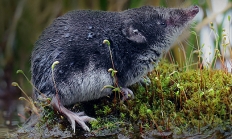
Preble's shrew is the smallest shrew in Oregon; adults commonly weigh less than a dime. The pelage is medium dark-brown to very dark-gray on the dorsum and silvery gray on the venter. The tail is bicolored, medium dark-brown on the dorsal surface, white on the ventral surface and darkening toward the tip. In Oregon, it has been found in Deschutes, Grant, Klamath, Lake, Harney, Malheur, and Wallowa counties. Its habitats include marshes, along streams, dry bunchgrass, and wet, alkaline habitat. Grasses and sagebrush are common to most habitats.
The fog shrew is the largest of the brown shrews in Oregon. Its range extends from Taft in Lincoln County east to near the eastern boundaries of Linn and Lane counties (except it is absent in the Willamette Valley) and southward along the west slope of the Cascade Range and in the Coast Range and Siskiyou Mountains. They are found in alder/salmonberry, riparian alder, and skunk cabbage marsh habitats and less often in conifer habitats.
Trowbridge's shrew is a medium-sized shrew, distinguished from other Oregon shrews by its dark-brown or grayish black pelage on both dorsum and venter, and its sharply bicolored tail, white below and dark brown or grayish black above. In Oregon, its range is west and south of a line connecting Parkdale, Hood River County; Pine Grove, Wasco County; Alder Spring, Lane County; Diamond Lake, Douglas County; Gearhart Mountain, Lake County; and Lakeview, Lake County. It occurs in all stages of the coniferous forest from old growth to recent clear-cuttings. Photo by Don Henise, Flickr

The shrew-mole is the smallest talpid in Oregon. The pelage is black; the eyes are rudimentary. The tail is about 50 percent of the length of the head and body, fat, sparsely haired, blunt ended, covered with transverse annular rows of scales and tufted. In Oregon, the species occurs as far east as Brooks Meadows, Hood River County; Indian Ford Campground, Deschutes County; and Fort Klamath, Klamath County. It is most abundant in moist sod-free ravines with deep, black-silt soils with high humus content and covered with a layer of dead leaves and twigs. Dominant vegetation in these areas is

The broad-footed mole is intermediate in size among Oregon moles. It occurs south of a line connecting Hugo, Josephine County; Prospect, Jackson County; Crater Lake, Klamath County; and Fort Rock and Goose Lake, Lake County. Photo from Panegyrics of Granovetter, Flickr
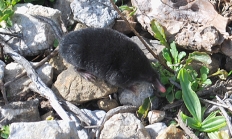
The coast mole is the smallest of the moles in Oregon. It occurs in Baker, Umatilla, Grant, Crook, Union, Sherman and Wasco counties east of the Cascade Range and throughout most areas west of the Cascade Range, except it is absent from much of the Willamette Valley. Photo by Peter Paquet, Flickr
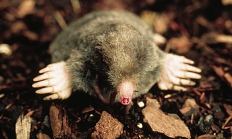
Townsend's mole is the largest talpid in Oregon. In Oregon, it is restricted to the interior valleys and coastal regions west of the foothills of the Cascade Range. It occupies pastures, prairies, and shrub habitats in lowlands and river flood plains. The highest densities were recorded in pasture areas in Tillamook County. Photo by J. Maughn, Flickr
California myotis is an acrobatic flyer. It is dark brown to blond with dark ears, and feeds on moths and flies. Early in the summer, a female joins a maternity or nursery colony where she gives birth to one offspring. In winter, these bats roost in mines, caves and buildings. The California myotis is an Oregon Conservation Strategy Species found throughout the state except for the Columbia Basin. Photo by ©Michael Durham

The Western small-footed myotis is among the smaller bats in Oregon and is brown to pale yellow with black ears and a black mask across its eyes and nose. It lives in dry climates, especially cliffs and rocks, and forages back and forth along the face of cliffs. It hibernates in caves and mines from November through February. In Oregon, the species only occurs east of the Cascade Range. Photo by ©Michael Durham

The long-eared myotis is pale brown to strawberry. It is a slow flier and hovers around trees and rocks to catch flies, moths and wasps. It is primarily a bat of coniferous forests in much of Oregon but may occur far from trees in shrub-steppe regions of the state. It forages in openings in dense forest, between the trees beneath the canopy in ponderosa pine, and over willow-bordered creeks. The species is known to enter dwellings and other buildings through open windows and doors, and to forage on moths therein. The long-eared myotis often day roosts in buildings, but may
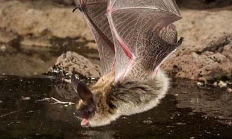
This bat is commonly found in attics and buildings during summer months in maternity colonies. It weighs about half an ounce and has a wingspan of nine to 11 inches. It prefers to live in forests near water. One baby is born in spring or summer. In winter, this bat hibernates in caves. The little brown myotis occurs throughout Oregon in a wide variety of habitats, but seems especially prone to establish residence near a lake, pond, or stream. Photo by ©Michael Durham

This bat is brown to reddish brown and has relatively long forearms. It gets its name from the fringe of hairs along the bottom of its tail. It roosts in trees, snags, buildings, caves, rocks, cliffs and bridges. It likes beetles and moths but will eat spiders and crickets. The fringed myotis occurs in the Coast Range from Jackson County to Clatsop County and in the northeastern corner of the state. It's an Oregon Conservation Strategy Species in seven of the nine ecoregions. Photo by ©Michael Durham

The long-legged myotis lives in forests and comes out early in the evening to hunt. It is a fast flier and will chase insects for a long distance. One baby is born in the summer, and the species hibernates in winter. In general, the long-legged myotis is a species associated with montane coniferous forests, but it also occurs in some desert and riparian habitats. The long-legged myotis is an Oregon Conservation Strategy Species in these ecoregions: Blue Mountains, Coast Range, East and West Cascades, Klamath Mountains, and Northern Basin and Range. Photo by ©Michael Durham
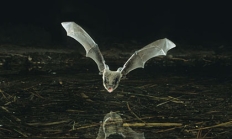
Yuma myotis emerges when it is almost dark and forages for insects over streams and ponds. This bat is gray, tan or brown; it lives in a variety of habitats. Large numbers of female bats gather together in May or June to have their young. In autumn, they migrate. Yuma myotis is found throughout the state and is associated more closely with water than any other North American species of bat. Photo by ©Michael Durham

The hoary bat has a wingspan of nearly 16 inches. It has dark fur tipped with white, a dark mask on its face, a yellow-orange throat and round ears edged in black. This bat roosts in branches of trees and likes to feed around outdoor lights. Hoary bats migrate south in winter, returning to Oregon in the spring. This bat usually bears twins. Hoary bats are found at scattered localities over most of the region west of the Cascade Range and in montane regions east of the Cascade Range. They are an Oregon Conservation Strategy Species in all ecoregions except

This bat, found in older forests, has a wingspan of about 10 inches. Its fur is glossy black, tipped with white. It forages over ponds, streams, meadows and roads, often flying very low and roosting behind loose tree bark. Maternity roosts of the silver-haired bat are found in trees. This bat usually bears twins. The silver-haired bat occurs statewide in Oregon except for most of the Columbia Basin and is an Oregon Conservation Strategy Species in all ecoregions except the Nearshore ecoregion. It is primarily associated with coniferous forests, including the juniper woodlands in the southeastern portion of the state

The canyon bat weighs less than one quarter of an ounce! Its fur is pale yellow to brownish gray with a dark face mask. It lives in eastern Oregon, likes rocky canyons and outcrops and flies early in the evening when it feeds on swarms of flying insects. Photo by ©Michael Durham

The big brown bat is a relatively large bat with a wingspan of 13 to 14 inches. Its dark color and slow flight help with identification. They are more likely to be active in cold weather than other bats and prefer human structures for roosting. The big brown bat occurs throughout the state. In eastern Oregon it forages over the forest canopy, along roads through the trees, along the forest edge, over forest clearings, and along cliffs and canyon streams. In western Oregon, the species is usually associated with coniferous and deciduous forests. Photo by ©Michael Durham

Spotted bats are rare in North America, living in dry climates and often roosting on high cliffs. They are white underneath with dark fur on their back and with large white spots. The spotted bat is found in eastern Oregon and is an Oregon Conservation Strategy Species in the Blue Mountains, Columbia Plateau, East Cascades, Klamath Mountains and Northern Basin and Range ecoregions. Photo by ©Michael Durham

